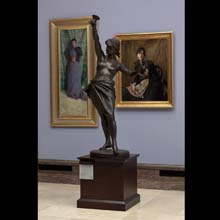
material: bronze
dimensions: 199 × 93 × 73 cm
description: A young, clearly amused woman seems to be walking towards the viewer with a dancing step. Her shapely figure has been captured in an agile pose, and her body is covered only by a fabric carelessly wrapped around her hips. The girl is lifting a goblet with a brisk gesture of her right hand. The Dionysian character of this work, suggested in the title, is highlighted by a twig of vine held in the dancer’s left hand. The popularity of this kind of representation in 19th-century sculpture was probably connected with the rehabilitation of Rococo art. It was largely contributed to by the Goncourt brothers, who published a collection of essays entitled L’Art du XVIIIe siècle (1859–1875). However, the form of Rygier’s work is far from the boudoir style of neo-Rococo, and at the same time it goes beyond the scope of the classical tradition, which enjoyed immense popularity in Polish art. Instead of cold guardedness, the artist used realistic observation. The sitter’s natural pose and expression are an allusion to the “picturesque” trend in Romantic sculpture, which paved the way for realism. It is not without significance for his style that Teodor Rygier spent a considerable part of his career in Italy, the cradle of verismo in sculpture. Rygier – a recognized portraitist – has given the girl’s face individual features. Her open, smiling mouth and slightly squinted eyes enhance the frivolous character of this work. The meticulous rendering of detail, which can be seen especially in the part of sandals tied around the girl’s ankles, does not diminish the free expression of the figure. Agata Małodobry
exposition: The Gallery of 19th Century Polish Art in Sukiennice,
The Cloth Hall, 1, Main Market Square
key: Realism, polish impressionism, beginnings of symbolism >>>
dimensions: 199 × 93 × 73 cm
description: A young, clearly amused woman seems to be walking towards the viewer with a dancing step. Her shapely figure has been captured in an agile pose, and her body is covered only by a fabric carelessly wrapped around her hips. The girl is lifting a goblet with a brisk gesture of her right hand. The Dionysian character of this work, suggested in the title, is highlighted by a twig of vine held in the dancer’s left hand. The popularity of this kind of representation in 19th-century sculpture was probably connected with the rehabilitation of Rococo art. It was largely contributed to by the Goncourt brothers, who published a collection of essays entitled L’Art du XVIIIe siècle (1859–1875). However, the form of Rygier’s work is far from the boudoir style of neo-Rococo, and at the same time it goes beyond the scope of the classical tradition, which enjoyed immense popularity in Polish art. Instead of cold guardedness, the artist used realistic observation. The sitter’s natural pose and expression are an allusion to the “picturesque” trend in Romantic sculpture, which paved the way for realism. It is not without significance for his style that Teodor Rygier spent a considerable part of his career in Italy, the cradle of verismo in sculpture. Rygier – a recognized portraitist – has given the girl’s face individual features. Her open, smiling mouth and slightly squinted eyes enhance the frivolous character of this work. The meticulous rendering of detail, which can be seen especially in the part of sandals tied around the girl’s ankles, does not diminish the free expression of the figure. Agata Małodobry
exposition: The Gallery of 19th Century Polish Art in Sukiennice,
The Cloth Hall, 1, Main Market Square
key: Realism, polish impressionism, beginnings of symbolism >>>












